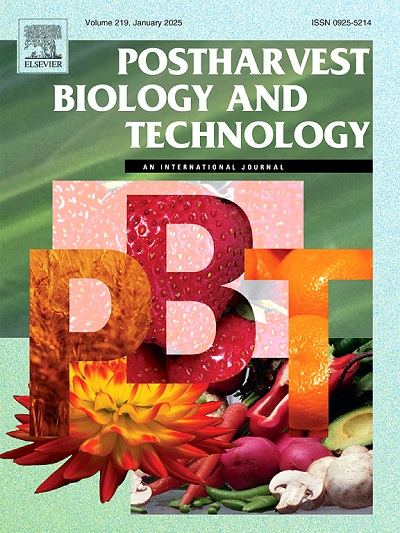红毛丹果皮和棘褐变过程中的水运输、维管束完整性和酶活性
IF 6.4
1区 农林科学
Q1 AGRONOMY
引用次数: 0
摘要
收获后红毛丹(Nephelium lappaceum L.)由于加速水分流失和刺和果皮的褐变而迅速失去其视觉质量。值得注意的是,红毛丹刺的失水和褐变进程明显快于果皮。为了研究水分流失对酶促褐变细胞结构变化的影响,对红毛丹果皮贮藏过程中的水分状况和分布进行了分析。此外,还观察了果皮和棘的超微结构。与果皮相比,棘的水分流失明显更多,褐变程度也更严重。低场核磁共振图像表明,在储存过程中,果皮向棘的供水停止。超微结构观察表明,贮藏过程中木质部导管的细胞结构被破坏,棘部韧皮部消失。这可能终止了果皮和棘之间的水力连接。脊髓严重失水破坏了血浆膜、囊泡膜和线粒体结构。贮藏期间,与果皮相比,多酚氧化酶、过氧化物酶和苯丙氨酸解氨酶活性较高,酚类物质下降较快,邻醌类物质积累较快。这些结果表明,严重的水分流失可能与维管束的破坏有关,从而导致果皮供水不足。严重的水分流失进一步导致细胞区隔化的破坏,促进了与褐变有关的酶和酚类物质之间的接触。因此,这加剧了脊柱的褐变。本文章由计算机程序翻译,如有差异,请以英文原文为准。
Water transport, vascular bundle integrity, and enzymatic activity in rambutan pericarp and spine browning
Postharvest rambutan (Nephelium lappaceum L.) rapidly loses its visual quality owing to accelerated water loss and browning of the spines and pericarp. Notably, the water loss and browning of the rambutan spines progress significantly quicker than that of the pericarp. To investigate the impact of the loss of water on the structural changes of the cell induced by enzymatic browning, the water status and distribution of rambutan peel during storage were analyzed. In addition, the ultrastructure of the pericarp and spines was observed. The spines lost significantly more water and browned more intensively compared to the pericarp. The low field NMR images suggested that the supply of water from the pericarp to the spines ceased during storage. Ultrastructural observations showed that the cell structure of vessels in the xylem was destroyed, and the phloem disappeared in the spines during storage. This probably terminated the hydraulic connectivity between the pericarp and spines. The severe water loss in the spines destroyed the plasma and vesicle membranes and the mitochondrial structure. Compared to the pericarp, the spines had higher levels of activities of polyphenol oxidase, peroxidase, and phenylalanine ammonia lyase during storage, which was accompanied by a more rapid decrease in the phenolics and a quicker accumulation of o-quinones. These results suggested that severe water loss in the spines may be associated with disruption of the vascular bundles, which leads to an insufficient water supply from the pericarp. The severe water loss further caused a breakdown of cellular compartmentalization, which facilitated contact between the enzymatic related to browning and the phenolics. Thus, this exacerbated browning in the spines.
求助全文
通过发布文献求助,成功后即可免费获取论文全文。
去求助
来源期刊

Postharvest Biology and Technology
农林科学-农艺学
CiteScore
12.00
自引率
11.40%
发文量
309
审稿时长
38 days
期刊介绍:
The journal is devoted exclusively to the publication of original papers, review articles and frontiers articles on biological and technological postharvest research. This includes the areas of postharvest storage, treatments and underpinning mechanisms, quality evaluation, packaging, handling and distribution of fresh horticultural crops including fruit, vegetables, flowers and nuts, but excluding grains, seeds and forages.
Papers reporting novel insights from fundamental and interdisciplinary research will be particularly encouraged. These disciplines include systems biology, bioinformatics, entomology, plant physiology, plant pathology, (bio)chemistry, engineering, modelling, and technologies for nondestructive testing.
Manuscripts on fresh food crops that will be further processed after postharvest storage, or on food processes beyond refrigeration, packaging and minimal processing will not be considered.
 求助内容:
求助内容: 应助结果提醒方式:
应助结果提醒方式:


